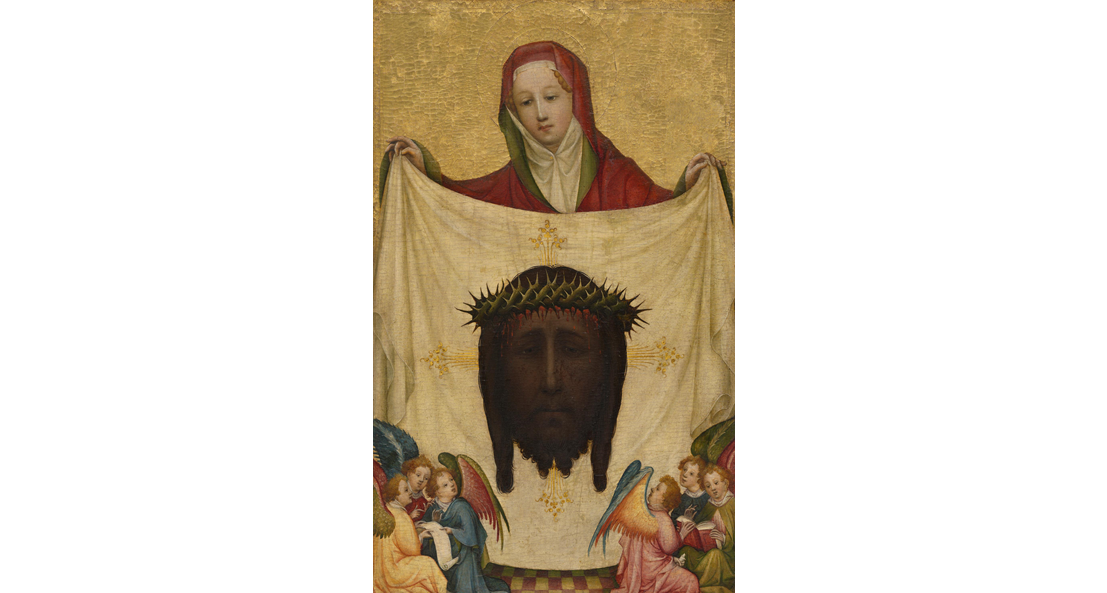+39 0669887260 | info@wucwo.org | Contact us
Art for meditation - September 2023

Master of Saint Veronica (active between 1400 and 1425), St. Veronica with the Holy Kerchief, c. 1425, oil on panel (fir wood), 78.1 x 48.2 cm, Munich, Alte Pinakothek
Women of the New Testament: Veronica.
Accompanying him were the Twelve and some women who had been cured of evil spirits and infirmities, Mary, called Magdalene, from whom seven demons had gone out, Joanna, the wife of Herod's steward Chuza, Susanna, and many others who provided for them out of their resources. (Lk 8:2-3)
The women who had come from Galilee with him followed behind, and when they had seen the tomb and the way in which his body was laid in it, they returned and prepared spices and perfumed oils. Then they rested on the sabbath according to the commandment. (Lk 23:55-56)
Veronica is the name traditionally given to one of the women who followed Jesus throughout his preaching. Initially identified with the woman who bled and was healed only by touching Jesus' cloak (as narrated in the synoptic gospels, e.g., in Lk 8:43-48), from the 14th century onwards she was considered the protagonist of an episode that is not narrated in the canonical gospels. We therefore associate the name 'Veronica' with what in the tradition of the Church is proposed to us in the sixth station of the Way of the Cross: on the way to Calvary, she, one of the women disciples, wipes Jesus' face with a cloth from the sweat and blood dripping from the crowning with thorns.
I really like the idea of naming - in addition to Mary, Salome, Joanna, Susanna - another of the women - probably many, perhaps even more than the twelve apostles if you read the first passage from Luke above - who accompanied the three years of Jesus' preaching.
The scene has been very successful in artistic representations and numerous painters have tried their hand at the theme, not least because according to tradition, the woman later realised that the immaculate cloth with which she had dried Jesus had miraculously imprinted his face, what is commonly known as the 'holy face'.
The image we contemplate is quite ancient and especially close to the time when the story of Veronica and her veneration spread in the Catholic Church, identifying her as one of the 'pious women' who followed Jesus.
We have not even been told the name of the author of the panel now in the Pinakothek in Munich. And this remains his most famous painting, to the extent that the painter is precisely remembered as the “Master of Saint Veronica of Munich”.
The thing that immediately leaps to the eye when contemplating the painting is the absolute predominance of Christ's face in it. Veronica is in the background, her gaze does not cross with ours, but lowers almost as if to tell us that we in our turn must contemplate the holy face of Jesus imprinted in the linen with which she wiped it. And this cloth is spread out in all its grandeur so that everyone can look at the holy image imprinted on it. The six little angels in the foreground have also turned their gaze to the face of Jesus and raise their prayer to Him.
Veronica thus becomes the perfect image of the disciple: those who follow Jesus do not seek prominence in the proclamation of the Gospel, but quite simply bring the Lord's deeds and words to all so that each may encounter Him and thus be saved.
It is not for nothing that Veronica is wrapped in the gold background which, as we know, symbolises divinity.
We can only imagine the amazement of Veronica who, after seeing the tomb and the body of Jesus laid there on Friday, after having prepared aromas and perfumes on the Sabbath day, goes to the tomb early in the morning, with some other women, and finds it empty, and sees the angel announcing that Jesus is risen, and runs to the disciples…
The linen on which Jesus' face is imprinted thus becomes a relic of the resurrection, a sign of a presence that has conquered death, as witnessed by Jesus' open eyes staring back at us. And every time we see this holy face, there will be a woman, Veronica, who offers it, shows it, gives it.
(Contribution by Vito Pongolini)